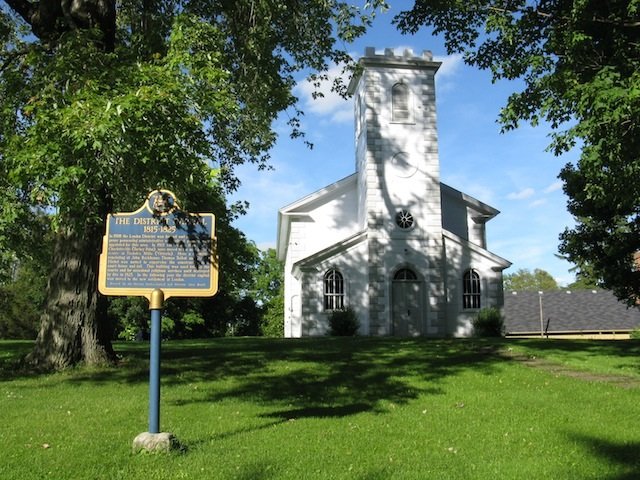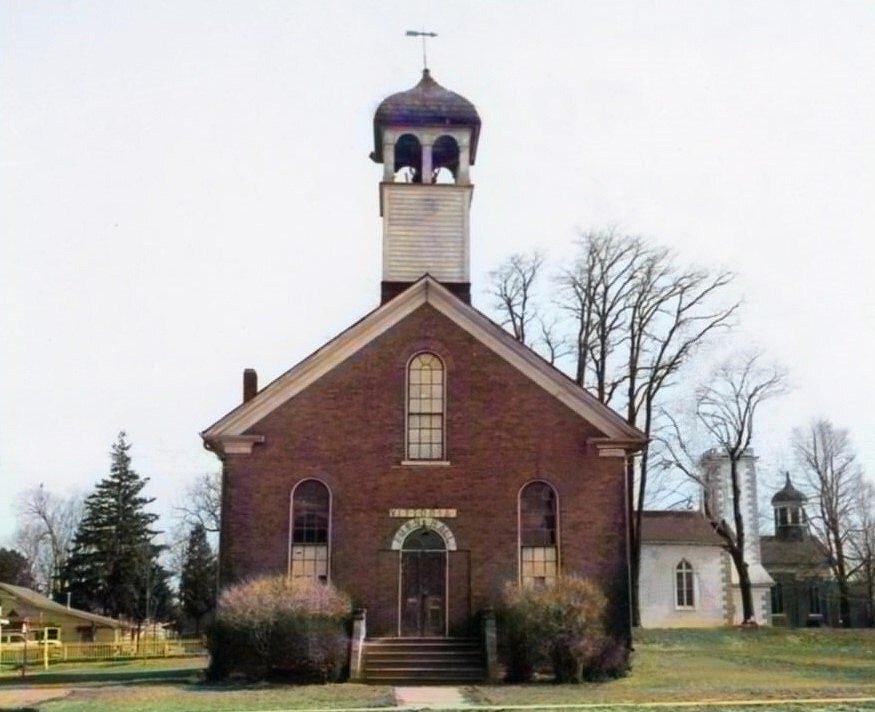The Historic Village Square
In May 1802, the Crown granted John Gustin 200 acres of land known as Lot 20, Concession 3, Charlotteville. Gustin sold 50 acres at the north end of this lot to S. Mabee, who in turn sold the property to Col. Robert Nichol. Nichol deeded a portion in the northern part of the 50 acres to be "in trust for public uses of the District of Talbot." This portion of land became known as the Court House Square.
Completion of the Court House, Gaol, and Registry Offices within the square in 1815 firmly established the village as the Capital of the London District and the most important post between York (Toronto) and Detroit in the United States. Official duties for the District continued in Vittoria until November 14, 1825, when the Court House was destroyed by fire. Subsequently, the District was moved to London, ON and the decade-long distinction of being the Capital ended for Vittoria.
For several years the ruins of the Court House remained in the square. In June of 1841, part of the square was sold to Thomas Lamport by the Clerk of the Peace for Talbot District, William Wilson. By 1847, Lamport, a successful merchant, had built a two story brick building, known at the Lamport Block, on the northwest corner of Brock (Main Street) Lamport Streets. The street level of the block contained shops with lodging on the second floor.
In 1843, the Diocese of Huron purchased the section of the square which contained the Court House ruins and by November 1844, the areas Anglican congregation had erected Christ Church, Church of England. Today, Christ Church stands as the last of its architectural style from this period in all of Canada.



On June 20, 1862, a subscription list was issued of citizens who promised to donate certain sums for the purpose of building a Public Hall in Vittoria. The building was also to be used for meetings of the Division Court. The following conditions were included with the subscription list: "Site to be given by Mr. Thomas Lamport and building to be erected within six months from date to be ready for next Township meeting, to be held in January next, 1863."
The publishing of this subscription list coincides with the deeding of "part of the south end of Lot 20, Concession 3, Charlotteville, better known as Village Lot B (Block 17)" by Thomas Lamport and his wife Lydia, to the Vittoria Lecture Room Company. This transaction was registered in December 1862. The subscription list for the building of the Public Hall contained 34 names and the records indicate a total of $1055 subscribed!
One of the events, according to an old advertisement, this first Public Hall in Vittoria hosted was a Grand Musical Entertainment in aid of the Vittoria Brass Band on Thursday evening, May 24, 1866. Unfortunately the Hall was destroyed by fire sometime before March 5, 1870, for on this date a number of "members and subscribers of the Vittoria Lecture Room Joint Stock Company" pledged support to rebuild the Vittoria Public Hall or Lecture Room. The Hall was to be "rebuilt with brick as soon as possible".
Included with the list of subscribers was a sketch of the Town Hall as it was to be built and which somewhat resembles it today. There were 21 subscribers this time. The total from the subscribers amounted to $625. They were to pay their subscribed amount to William Finlay of Vittoria as Treasurer, half on the 1st day of May and the rest on the 1st of October. The building was "to be erected and finished according to the site plan and elevation as agreed upon by a majority of five persons chosen by ballot" as a building committee. The building therefore, was most likely completed by the end of 1870.
On December 1, l915, The Vittoria Lecture Room Company leased the Town Hall Property (north easterly part of Lot B, Block 17, Plan 29-B) to the Trustees of the Police Village of Vittoria for a period of 999 years.
The Trustees were to pay the sum of one dollar each year of the lease and were to be responsible for the taxes and the maintenance and fencing of the property. They were also to insure the Hall for fire, in case of which the building was to be rebuilt to its former condition. It was, according to the lease, "to be always used for the purposes of a public hall - or a place for exhibitions by said Village or for any other necessary purpose."
Also, according to the lease, the Trustees could not sublet the building without permission from the Lecture Room Company and must pay each year all money required for the Company's meetings. They were also responsible for any costs incurred by the Company to file annual statements and for the costs it might have in order to adhere to any laws of Ontario or Canada that might occur in the future. If such costs were presented to the Trustees, they were to be paid within ten days.
The lands were dedicated as park land for public use only, and under no circumstances was the sale of alcohol or the parking of vehicles to be permitted. The lease was signed by John Pow, president; R. W. McCall, secretary; James Dyer and J. C. McLennan and witnessed by Hetty Dyer, wife of James Dyer. The legalities certainly developed at a slow pace as the lease began on December 1st, 1915 but was not signed until June 2nd 1917.
On the 1st day of May, 1962, the Trustees of the Police Village of Vittoria were also to become the recipients of the lot next to the Town Hall where the Lamport Block had previously stood. Emily Alice Blanche Lamport, widow of William A. Lamport, who had been a Barrister-at-Law in Toronto and whose grandfather settled in Vittoria in or around the year 1800, donated the lot described as "being in the Township of Charlotteville, in the County of Norfolk, and being Block 17-C according to Vittoria Plan 29B" as a Park land in his memory.
The Trustees were to establish a "Lamport Memorial Garden" under the following conditions: there was to be no commercial venture permitted on the lands and under no circumstances was the sale of wine, beer or spiritual liquors to be permitted. A monument, at the expense of the Trustees, was also to be erected and maintained, as she had instructed, bearing the following inscription, "This park is the gift of Mrs. William A. Lamport in memory of her husband, who died in the year 1961 at the age of 95 years, and knowing that it would be his wish, as he loved Vittoria, the place of his birth". The Trustees were also to be responsible for all taxes and any other charges subsequent to the 31st of December 1961, the maintenance of the park and the erection and care of fencing around it.
A few years later, when the Vittoria Lamport Club (New Horizons) - the name having been chosen due to the above previous history - was organized in 1976, a Grant was received from the New Horizons and from the Township of Delhi, which, as a result of government reorganization, has inherited the responsibilities of the former Trustees. This money was used to secure items required for the operation of the Club which included the drilling of a well, a new roof at the Town Hall, where Club meetings were to be held, and the installation of washrooms, drapes, a refrigerator, etc. at the Hall.
In 1996, the 126-year-old Town Hall as well as the Lamport Memorial Garden were "spruced up" in preparation for Vittoria's Bicentennial celebrations. New front steps, a new roof, the painting of the interior and other required maintenance brought new life to this historical building, which was the centre of public life in the hamlet of Vittoria.
In 1998, a study was done to assess the condition of the Town Hall. It was found that, although the 128-year old building is in generally good condition, there are deficiencies, some rather serious, which should be addressed immediately. Some citizens suggested that it would be a great project to celebrate the new millennium, and The Vittoria & District Foundation Inc. was approached to spearhead the repairs with the hope that the historic landmark in the Village Square remain for generations to come.
Representatives from The Foundation met with other stakeholders who shared an interest in preserving the village heritage, and found considerable enthusiasm to proceed, provided sufficient assistance come from the Canada Millennium Partnership Program.
The Vittoria Town Hall explores our heritage, celebrates the achievements of our founding fathers and other ancestors, and will leave a lasting legacy for years to come.